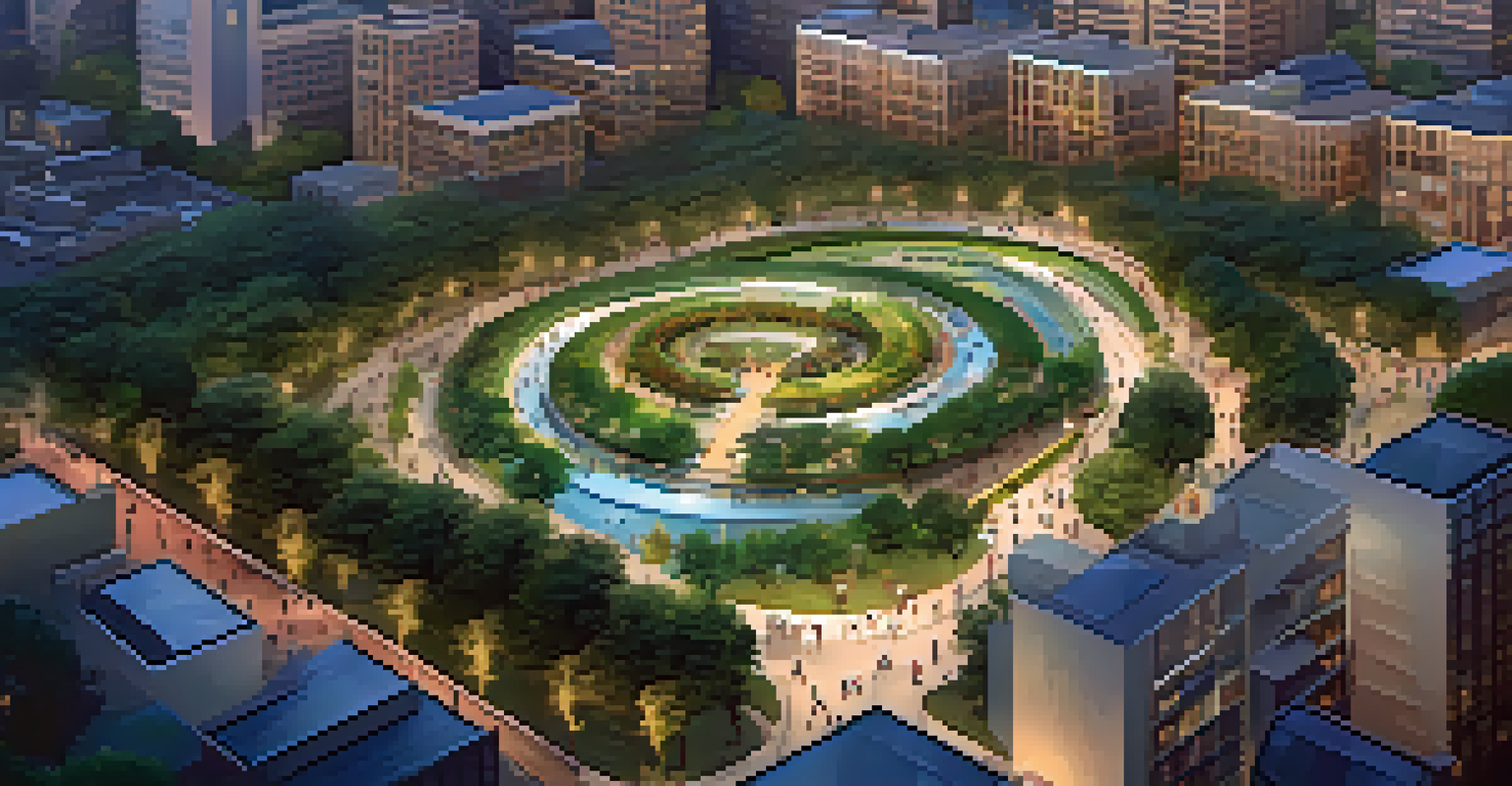Smart Parks: Integrating Nature into Urban Environments

The Concept of Smart Parks in Urban Areas
Smart parks are innovative green spaces designed to enhance urban living. They combine technology with nature to create environments that promote sustainability and community well-being. Imagine a park that not only offers a breath of fresh air but also features smart lighting, Wi-Fi, and interactive displays.
The parks are a place where nature and community come together, creating a sanctuary for all.
The goal is to make these parks not just recreational areas, but vital parts of the urban ecosystem. They serve as places for relaxation, social interaction, and even education about the environment. By integrating nature into cities, smart parks help to reduce urban heat and improve air quality.
These parks act as a bridge between technology and nature, encouraging people to engage with their surroundings. They highlight the importance of green spaces in urban planning, reminding us that nature can coexist with modern living. Ultimately, smart parks are about creating a sustainable future for our communities.
Benefits of Integrating Nature into Urban Spaces
Integrating nature into urban environments offers numerous benefits for residents and ecosystems alike. Green spaces help to enhance mental well-being, reduce stress, and encourage physical activity. For instance, a stroll through a lush park can uplift your mood and provide a refreshing escape from city life.

Moreover, parks play a crucial role in improving air quality by filtering pollutants. Trees and plants absorb carbon dioxide and release oxygen, making our cities healthier places to live. This is especially important as urban areas continue to grow and face challenges like pollution and climate change.
Smart Parks Combine Nature and Tech
These innovative green spaces enhance urban living by integrating technology with nature to promote sustainability and community well-being.
Additionally, smart parks foster community connections by providing a space for social gatherings and activities. Events like outdoor yoga classes or farmers’ markets can bring people together, strengthening community ties. Ultimately, these benefits make a compelling case for prioritizing green spaces in urban planning.
Technological Innovations in Smart Parks
Technology plays a pivotal role in the development of smart parks. From sensors that monitor air quality to smart irrigation systems, these innovations enhance the user experience and promote sustainability. For example, a park might use sensors to adjust lighting based on foot traffic, ensuring safety while conserving energy.
In every walk with nature one receives far more than he seeks.
Interactive features, such as mobile apps, allow visitors to navigate the park and learn about its flora and fauna. Imagine using your phone to identify a tree or receive updates about park events. This integration of technology makes nature more accessible and engaging for everyone.
Moreover, technology can help park managers optimize maintenance and resource use. Data collected from various sensors can inform decisions about water usage, plant health, and visitor patterns. This efficiency not only saves costs but also ensures that parks remain vibrant and welcoming spaces.
Case Studies: Successful Smart Parks Around the World
Looking at successful examples of smart parks can inspire other cities to follow suit. One notable case is the High Line in New York City, where an abandoned railway was transformed into a vibrant urban park. It features lush gardens, art installations, and provides a unique perspective of the city.
Another example is the Smart Park in Singapore, which uses cutting-edge technology to monitor biodiversity and water quality. This park not only serves as a recreational area but also as a living laboratory for environmental research and education. Such initiatives show how urban parks can be multifunctional and beneficial.
Community Engagement is Essential
Involving local residents in the planning and development of smart parks fosters a sense of ownership and enhances the park experience.
These case studies highlight the importance of local context in designing smart parks. Each park reflects the unique cultural, environmental, and social needs of its community. By learning from these examples, cities can create their own successful green spaces tailored to their residents.
Community Engagement in Smart Park Development
Community involvement is crucial in the development of smart parks. Engaging locals in the planning process ensures that parks meet the needs and preferences of residents. This can be achieved through surveys, workshops, and public meetings, allowing everyone to voice their ideas.
When the community feels a sense of ownership, they are more likely to take care of the park and participate in its activities. Initiatives like volunteer days for park clean-ups or planting events foster pride and stewardship among residents. This connection helps create a vibrant and welcoming atmosphere.
Additionally, involving the community can lead to innovative ideas that enhance the park's features. Local artists might contribute sculptures or murals, while schools could organize educational programs. Such collaborations enrich the park experience, making it a true community hub.
Challenges in Creating Smart Parks
While smart parks offer numerous advantages, there are challenges to their implementation. One significant hurdle is funding; creating and maintaining these parks requires financial resources. Cities often need to balance budgets while investing in green spaces, which can lead to tough decisions.
Another challenge is the integration of technology in a way that complements nature rather than detracts from it. Striking the right balance between tech and tranquility is essential. Overly complex systems might create a sterile environment, whereas well-planned innovations can enhance the natural beauty of the park.
Challenges in Smart Park Implementation
Funding, technology integration, and ensuring accessibility are significant challenges that cities must address to successfully create smart parks.
Lastly, ensuring accessibility for all community members is crucial. Parks should be designed to accommodate people of all ages and abilities, which requires thoughtful planning and design. Addressing these challenges head-on can lead to the successful development of smart parks that truly benefit everyone.
The Future of Smart Parks in Urban Planning
The future of smart parks looks promising as cities increasingly recognize their value. As urban populations continue to grow, the need for green spaces becomes even more critical. Smart parks are set to play a key role in creating sustainable and livable cities.
Innovative designs and technologies will likely evolve, leading to even more multifunctional green spaces. Imagine parks that can adapt in real-time to weather changes, or ones that generate energy through solar panels integrated into park infrastructure. The possibilities are practically limitless.

Ultimately, the integration of smart parks into urban planning will require collaboration among city planners, technologists, and community members. By working together, we can create parks that not only enhance urban life but also foster a deeper connection between people and nature.